Variance Analysis in Management Accounting
VerifiedAdded on 2023/01/07
|12
|3140
|31
AI Summary
This document discusses variance analysis in management accounting, specifically focusing on sales price variance, sales volume contribution variance, material price planning variance, and material price operational variance. It also critically analyzes the merits and demerits of using variances in assessing managers' performance. Additionally, it explores the competitive advantage provided by FamaQ, the demand for chemical X and Y, and the final decision on whether to make or buy the raw material famaQ.
Contribute Materials
Your contribution can guide someone’s learning journey. Share your
documents today.
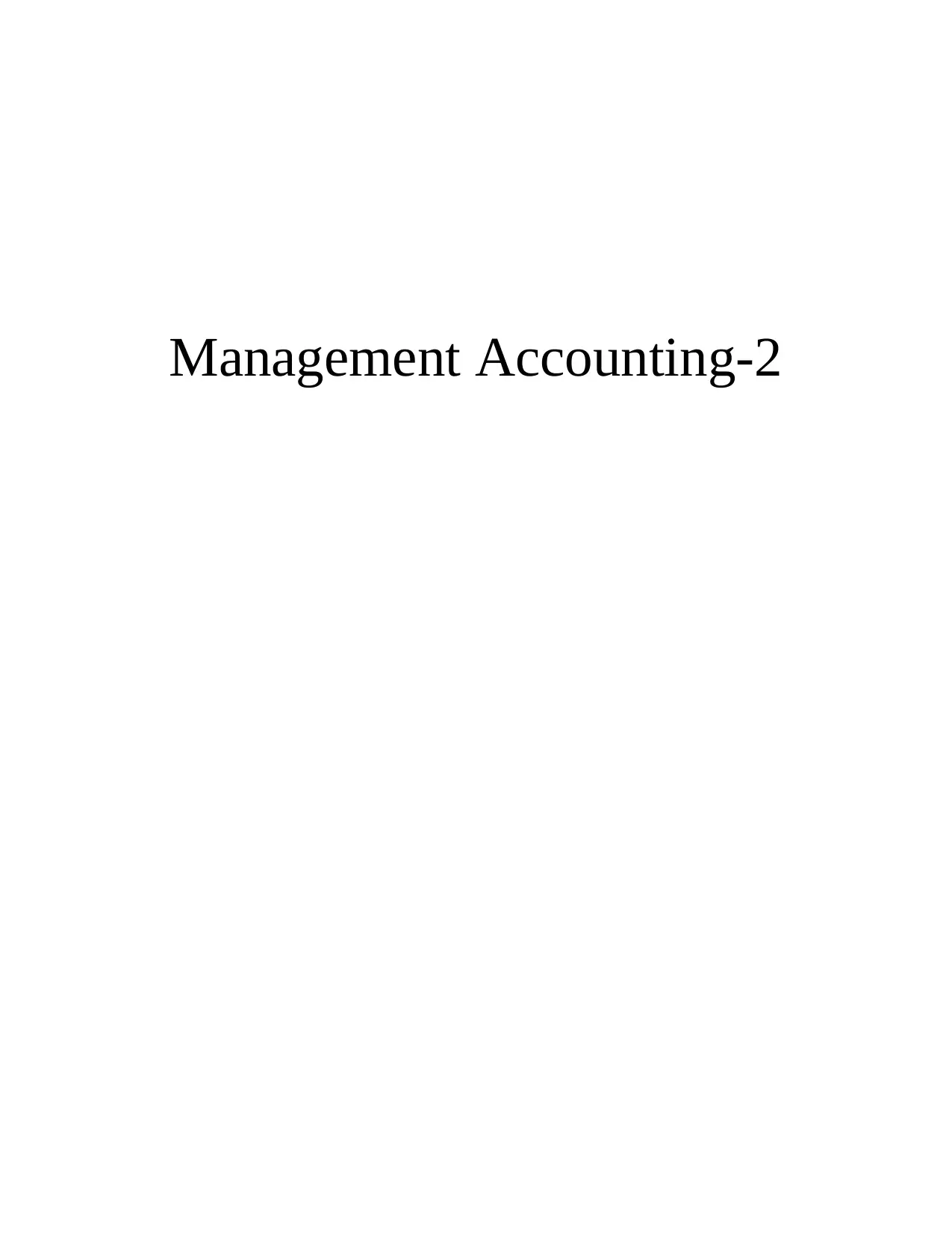
Management Accounting-2
Secure Best Marks with AI Grader
Need help grading? Try our AI Grader for instant feedback on your assignments.
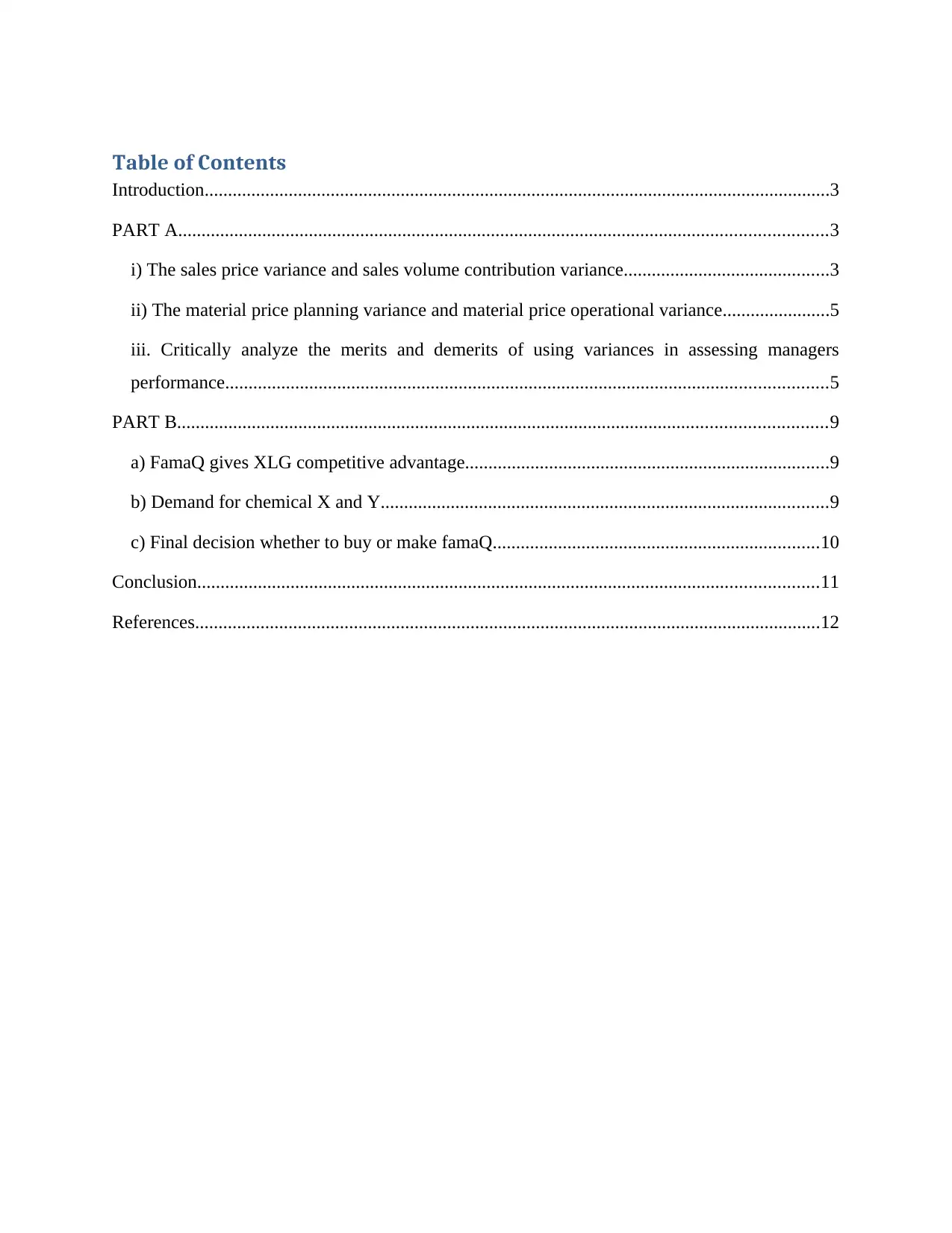
Table of Contents
Introduction......................................................................................................................................3
PART A...........................................................................................................................................3
i) The sales price variance and sales volume contribution variance............................................3
ii) The material price planning variance and material price operational variance.......................5
iii. Critically analyze the merits and demerits of using variances in assessing managers
performance.................................................................................................................................5
PART B...........................................................................................................................................9
a) FamaQ gives XLG competitive advantage..............................................................................9
b) Demand for chemical X and Y................................................................................................9
c) Final decision whether to buy or make famaQ......................................................................10
Conclusion.....................................................................................................................................11
References......................................................................................................................................12
Introduction......................................................................................................................................3
PART A...........................................................................................................................................3
i) The sales price variance and sales volume contribution variance............................................3
ii) The material price planning variance and material price operational variance.......................5
iii. Critically analyze the merits and demerits of using variances in assessing managers
performance.................................................................................................................................5
PART B...........................................................................................................................................9
a) FamaQ gives XLG competitive advantage..............................................................................9
b) Demand for chemical X and Y................................................................................................9
c) Final decision whether to buy or make famaQ......................................................................10
Conclusion.....................................................................................................................................11
References......................................................................................................................................12

Introduction
Variance analysis is an examination of deviations of actual behavior versus forecasted or planned
behavior in budgeting or management accounting. This is fundamentally concerned with how the
difference between real and organized practices shows how business performance is affected.
Substantial changes result from the difference between the actual costs of the materials used and
the normal costs of the materials determined for the goods delivered (Horngren, Datar and Rajan,
2015). This is probably the most important factor given the difference between the amount spent
and the amount originally divided for the creation. This may be due to the difference in the
processed value and the planned cost of the materials used. Although the change in value is the
difference between the normal cost and the actual cost.
This assignment carries two parts; A and B. In part A; calculation of sales price and sales volume
contribution variance has been done. Material price planning and operational variance will
highlight the difference between standard and revised standard output cost of raw material used
in producing chemicals X and Y. Merits and demerits of variance analysis has also been
discussed in this part. Part B consists of buy and makes decision of the raw material famaQ by
XLG Company. This part will also justify the reason behind choosing making of the product self
by company in UK itself.
PART A
i) The sales price variance and sales volume contribution variance
Budgeted Actual
Quantity
Price per
unit Total Quantity
Price per
unit Total
X Y X Y X Y X Y X + Y
Sales price 595 595 £35 £30 £17,850
85
0 750 £45 £30 £60,750
Sales price variance
Variance analysis is an examination of deviations of actual behavior versus forecasted or planned
behavior in budgeting or management accounting. This is fundamentally concerned with how the
difference between real and organized practices shows how business performance is affected.
Substantial changes result from the difference between the actual costs of the materials used and
the normal costs of the materials determined for the goods delivered (Horngren, Datar and Rajan,
2015). This is probably the most important factor given the difference between the amount spent
and the amount originally divided for the creation. This may be due to the difference in the
processed value and the planned cost of the materials used. Although the change in value is the
difference between the normal cost and the actual cost.
This assignment carries two parts; A and B. In part A; calculation of sales price and sales volume
contribution variance has been done. Material price planning and operational variance will
highlight the difference between standard and revised standard output cost of raw material used
in producing chemicals X and Y. Merits and demerits of variance analysis has also been
discussed in this part. Part B consists of buy and makes decision of the raw material famaQ by
XLG Company. This part will also justify the reason behind choosing making of the product self
by company in UK itself.
PART A
i) The sales price variance and sales volume contribution variance
Budgeted Actual
Quantity
Price per
unit Total Quantity
Price per
unit Total
X Y X Y X Y X Y X + Y
Sales price 595 595 £35 £30 £17,850
85
0 750 £45 £30 £60,750
Sales price variance
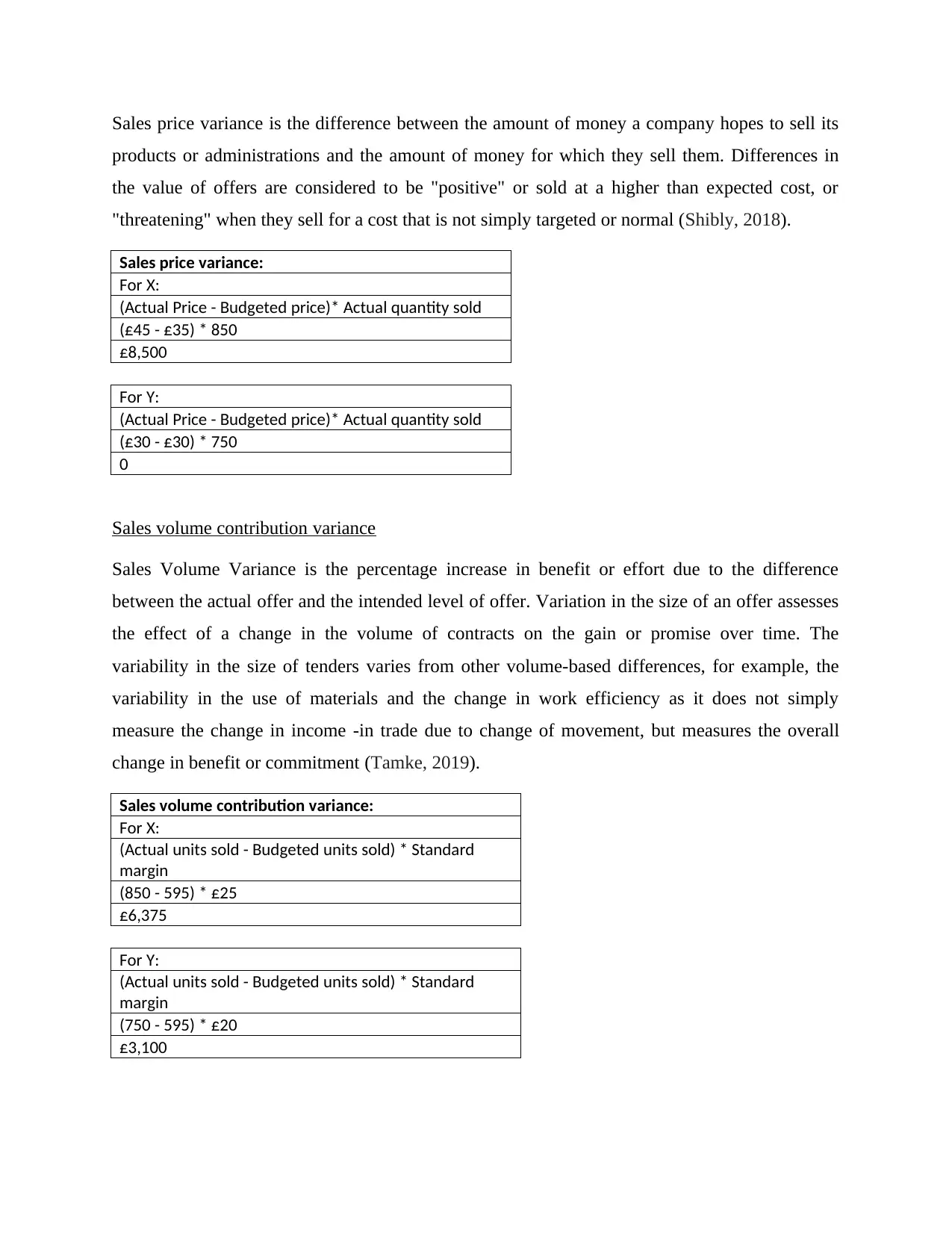
Sales price variance is the difference between the amount of money a company hopes to sell its
products or administrations and the amount of money for which they sell them. Differences in
the value of offers are considered to be "positive" or sold at a higher than expected cost, or
"threatening" when they sell for a cost that is not simply targeted or normal (Shibly, 2018).
Sales price variance:
For X:
(Actual Price - Budgeted price)* Actual quantity sold
(£45 - £35) * 850
£8,500
For Y:
(Actual Price - Budgeted price)* Actual quantity sold
(£30 - £30) * 750
0
Sales volume contribution variance
Sales Volume Variance is the percentage increase in benefit or effort due to the difference
between the actual offer and the intended level of offer. Variation in the size of an offer assesses
the effect of a change in the volume of contracts on the gain or promise over time. The
variability in the size of tenders varies from other volume-based differences, for example, the
variability in the use of materials and the change in work efficiency as it does not simply
measure the change in income -in trade due to change of movement, but measures the overall
change in benefit or commitment (Tamke, 2019).
Sales volume contribution variance:
For X:
(Actual units sold - Budgeted units sold) * Standard
margin
(850 - 595) * £25
£6,375
For Y:
(Actual units sold - Budgeted units sold) * Standard
margin
(750 - 595) * £20
£3,100
products or administrations and the amount of money for which they sell them. Differences in
the value of offers are considered to be "positive" or sold at a higher than expected cost, or
"threatening" when they sell for a cost that is not simply targeted or normal (Shibly, 2018).
Sales price variance:
For X:
(Actual Price - Budgeted price)* Actual quantity sold
(£45 - £35) * 850
£8,500
For Y:
(Actual Price - Budgeted price)* Actual quantity sold
(£30 - £30) * 750
0
Sales volume contribution variance
Sales Volume Variance is the percentage increase in benefit or effort due to the difference
between the actual offer and the intended level of offer. Variation in the size of an offer assesses
the effect of a change in the volume of contracts on the gain or promise over time. The
variability in the size of tenders varies from other volume-based differences, for example, the
variability in the use of materials and the change in work efficiency as it does not simply
measure the change in income -in trade due to change of movement, but measures the overall
change in benefit or commitment (Tamke, 2019).
Sales volume contribution variance:
For X:
(Actual units sold - Budgeted units sold) * Standard
margin
(850 - 595) * £25
£6,375
For Y:
(Actual units sold - Budgeted units sold) * Standard
margin
(750 - 595) * £20
£3,100
Secure Best Marks with AI Grader
Need help grading? Try our AI Grader for instant feedback on your assignments.
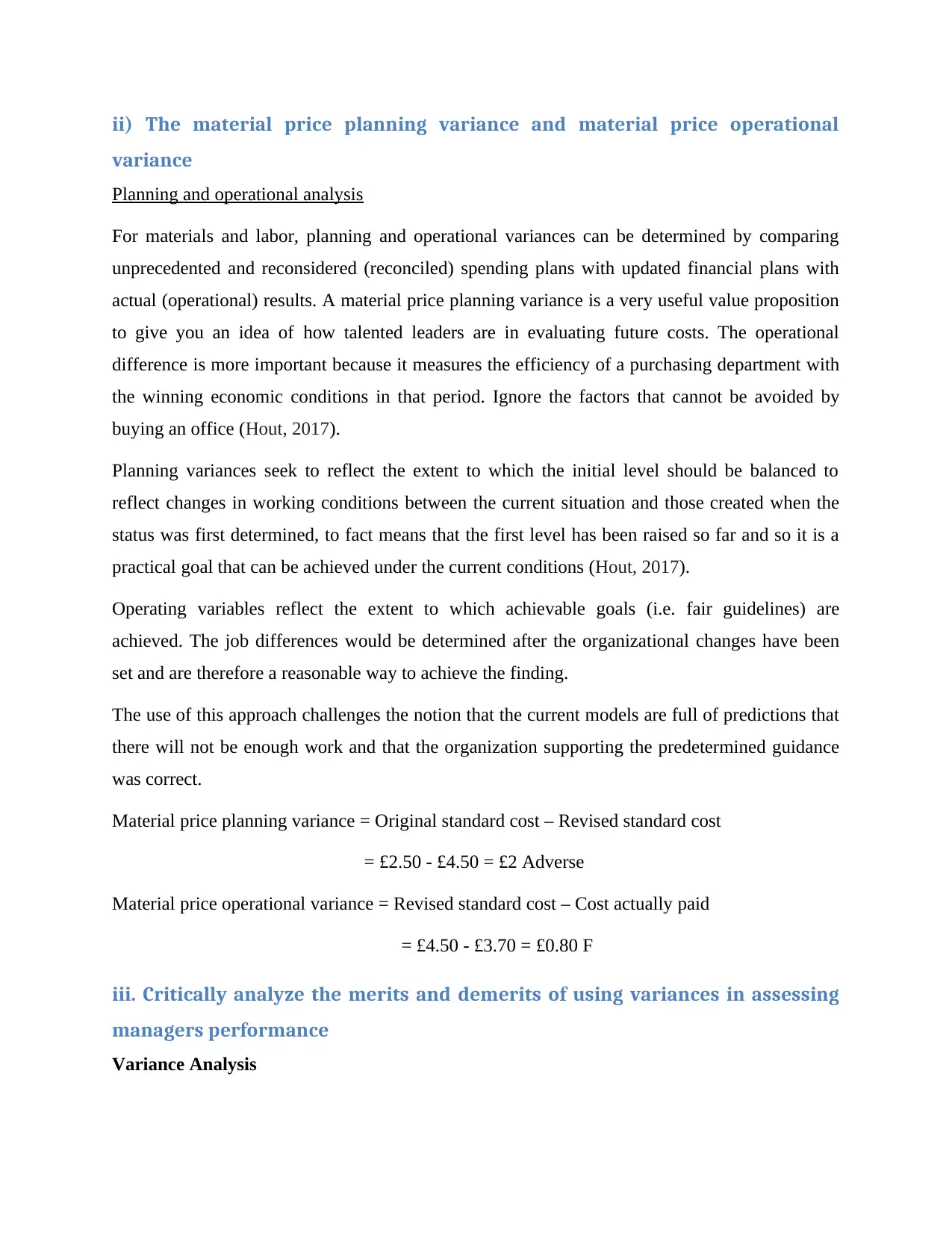
ii) The material price planning variance and material price operational
variance
Planning and operational analysis
For materials and labor, planning and operational variances can be determined by comparing
unprecedented and reconsidered (reconciled) spending plans with updated financial plans with
actual (operational) results. A material price planning variance is a very useful value proposition
to give you an idea of how talented leaders are in evaluating future costs. The operational
difference is more important because it measures the efficiency of a purchasing department with
the winning economic conditions in that period. Ignore the factors that cannot be avoided by
buying an office (Hout, 2017).
Planning variances seek to reflect the extent to which the initial level should be balanced to
reflect changes in working conditions between the current situation and those created when the
status was first determined, to fact means that the first level has been raised so far and so it is a
practical goal that can be achieved under the current conditions (Hout, 2017).
Operating variables reflect the extent to which achievable goals (i.e. fair guidelines) are
achieved. The job differences would be determined after the organizational changes have been
set and are therefore a reasonable way to achieve the finding.
The use of this approach challenges the notion that the current models are full of predictions that
there will not be enough work and that the organization supporting the predetermined guidance
was correct.
Material price planning variance = Original standard cost – Revised standard cost
= £2.50 - £4.50 = £2 Adverse
Material price operational variance = Revised standard cost – Cost actually paid
= £4.50 - £3.70 = £0.80 F
iii. Critically analyze the merits and demerits of using variances in assessing
managers performance
Variance Analysis
variance
Planning and operational analysis
For materials and labor, planning and operational variances can be determined by comparing
unprecedented and reconsidered (reconciled) spending plans with updated financial plans with
actual (operational) results. A material price planning variance is a very useful value proposition
to give you an idea of how talented leaders are in evaluating future costs. The operational
difference is more important because it measures the efficiency of a purchasing department with
the winning economic conditions in that period. Ignore the factors that cannot be avoided by
buying an office (Hout, 2017).
Planning variances seek to reflect the extent to which the initial level should be balanced to
reflect changes in working conditions between the current situation and those created when the
status was first determined, to fact means that the first level has been raised so far and so it is a
practical goal that can be achieved under the current conditions (Hout, 2017).
Operating variables reflect the extent to which achievable goals (i.e. fair guidelines) are
achieved. The job differences would be determined after the organizational changes have been
set and are therefore a reasonable way to achieve the finding.
The use of this approach challenges the notion that the current models are full of predictions that
there will not be enough work and that the organization supporting the predetermined guidance
was correct.
Material price planning variance = Original standard cost – Revised standard cost
= £2.50 - £4.50 = £2 Adverse
Material price operational variance = Revised standard cost – Cost actually paid
= £4.50 - £3.70 = £0.80 F
iii. Critically analyze the merits and demerits of using variances in assessing
managers performance
Variance Analysis

Variance analysis can be summarized as a study of the difference between planned and actual
numbers. The sum of the differences provides an indication of the overall higher or lower return
for a given publication period. On a case-by-case basis, organizations examine vulnerability by
looking at actual and industry-typical costs (Taschner and Charifzadeh, 2016). For example, if
the actual cost is less than the average cost for raw materials, with the expected size of similar
products, it would encourage a value conversion (for example, investment fund costs). However,
if the average quantity were 10,000 pieces of material and 15,000 pieces were needed, that would
be a negative variation as more materials were used than expected.
The process of variance analysis is simple. It’s just a comparing standards with actual.
Organizations usually set the principles by which real performance can be judged. The standard
positioning section is part of a budget control that administrative accountants apply their opinion
and expert ability together without causing more harm than anything else by using the design
cycle. The configuration of the variability check sheet is one of the duties / responsibilities of the
accountants in business. This is based on the importance of accounting in critical dynamics.
Merits of using variances in assessing mangers performance
PERFORMANCE MEASUREMENT
Less advanced bosses and diverse accounting data clients see the antagonist as such a horrible
and drastic change, if any. While variability analysis is a reasonable tool for assessing manager
performance, care must be taken when using this to avoid making costly mistakes and
assumptions (Marzlin Marzuki and Ismail, 2019).
RESPONSIBILITY ACCOUNTING
Record keeping is another authoritative expression used to show how leaders are held
accountable for what they do. Organizations are generally organized into sections (by capacity or
category) and will be responsible for the resources under consideration. The way in which the
analysis of change by object / department is conducted makes it extremely easy for managers,
offices or departments to be held accountable for any significant shift from the organized
business. Again, special attention should be paid to the use of differential analysis for duty book
keeping.
MANAGEMENT BY EXEMPTION
numbers. The sum of the differences provides an indication of the overall higher or lower return
for a given publication period. On a case-by-case basis, organizations examine vulnerability by
looking at actual and industry-typical costs (Taschner and Charifzadeh, 2016). For example, if
the actual cost is less than the average cost for raw materials, with the expected size of similar
products, it would encourage a value conversion (for example, investment fund costs). However,
if the average quantity were 10,000 pieces of material and 15,000 pieces were needed, that would
be a negative variation as more materials were used than expected.
The process of variance analysis is simple. It’s just a comparing standards with actual.
Organizations usually set the principles by which real performance can be judged. The standard
positioning section is part of a budget control that administrative accountants apply their opinion
and expert ability together without causing more harm than anything else by using the design
cycle. The configuration of the variability check sheet is one of the duties / responsibilities of the
accountants in business. This is based on the importance of accounting in critical dynamics.
Merits of using variances in assessing mangers performance
PERFORMANCE MEASUREMENT
Less advanced bosses and diverse accounting data clients see the antagonist as such a horrible
and drastic change, if any. While variability analysis is a reasonable tool for assessing manager
performance, care must be taken when using this to avoid making costly mistakes and
assumptions (Marzlin Marzuki and Ismail, 2019).
RESPONSIBILITY ACCOUNTING
Record keeping is another authoritative expression used to show how leaders are held
accountable for what they do. Organizations are generally organized into sections (by capacity or
category) and will be responsible for the resources under consideration. The way in which the
analysis of change by object / department is conducted makes it extremely easy for managers,
offices or departments to be held accountable for any significant shift from the organized
business. Again, special attention should be paid to the use of differential analysis for duty book
keeping.
MANAGEMENT BY EXEMPTION
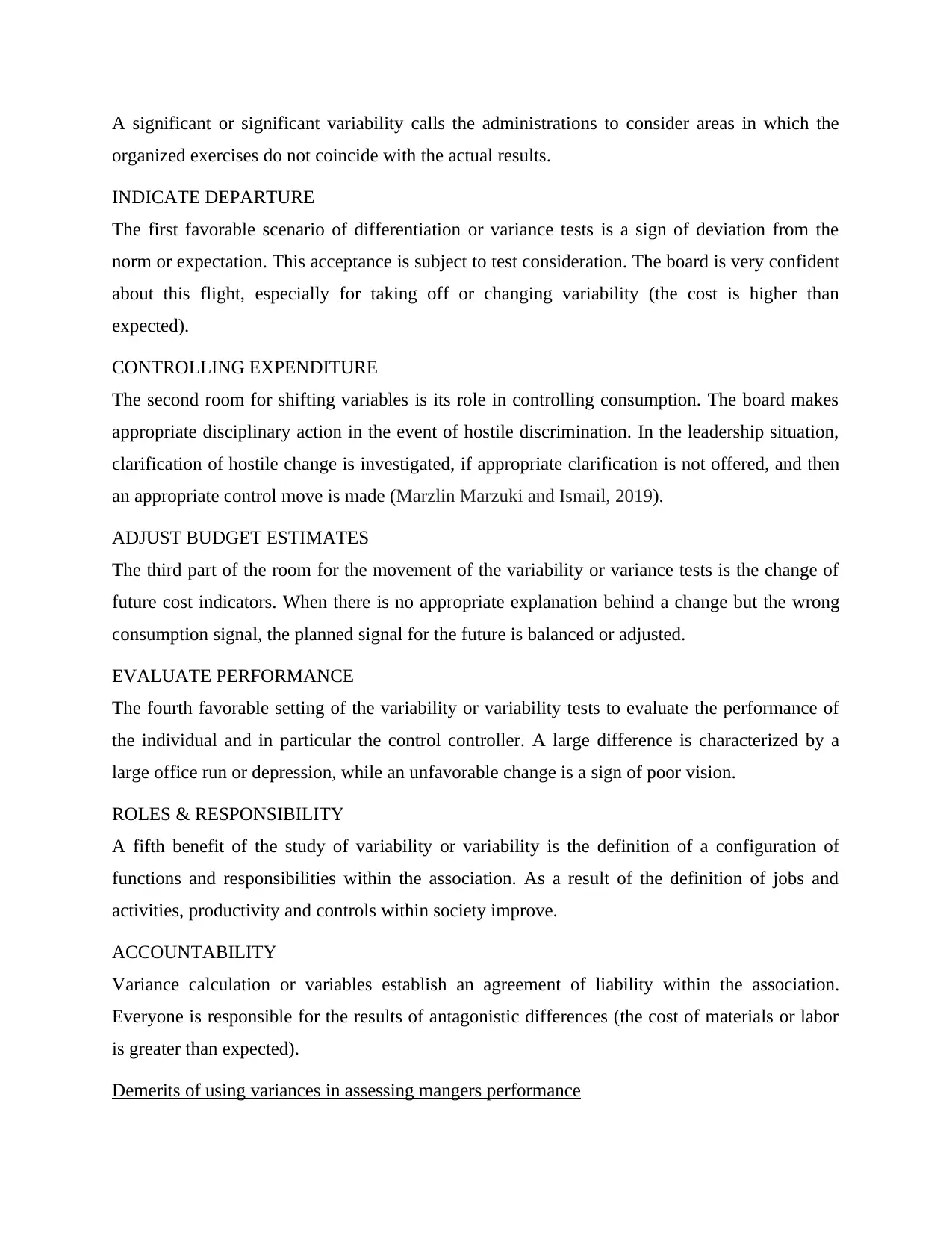
A significant or significant variability calls the administrations to consider areas in which the
organized exercises do not coincide with the actual results.
INDICATE DEPARTURE
The first favorable scenario of differentiation or variance tests is a sign of deviation from the
norm or expectation. This acceptance is subject to test consideration. The board is very confident
about this flight, especially for taking off or changing variability (the cost is higher than
expected).
CONTROLLING EXPENDITURE
The second room for shifting variables is its role in controlling consumption. The board makes
appropriate disciplinary action in the event of hostile discrimination. In the leadership situation,
clarification of hostile change is investigated, if appropriate clarification is not offered, and then
an appropriate control move is made (Marzlin Marzuki and Ismail, 2019).
ADJUST BUDGET ESTIMATES
The third part of the room for the movement of the variability or variance tests is the change of
future cost indicators. When there is no appropriate explanation behind a change but the wrong
consumption signal, the planned signal for the future is balanced or adjusted.
EVALUATE PERFORMANCE
The fourth favorable setting of the variability or variability tests to evaluate the performance of
the individual and in particular the control controller. A large difference is characterized by a
large office run or depression, while an unfavorable change is a sign of poor vision.
ROLES & RESPONSIBILITY
A fifth benefit of the study of variability or variability is the definition of a configuration of
functions and responsibilities within the association. As a result of the definition of jobs and
activities, productivity and controls within society improve.
ACCOUNTABILITY
Variance calculation or variables establish an agreement of liability within the association.
Everyone is responsible for the results of antagonistic differences (the cost of materials or labor
is greater than expected).
Demerits of using variances in assessing mangers performance
organized exercises do not coincide with the actual results.
INDICATE DEPARTURE
The first favorable scenario of differentiation or variance tests is a sign of deviation from the
norm or expectation. This acceptance is subject to test consideration. The board is very confident
about this flight, especially for taking off or changing variability (the cost is higher than
expected).
CONTROLLING EXPENDITURE
The second room for shifting variables is its role in controlling consumption. The board makes
appropriate disciplinary action in the event of hostile discrimination. In the leadership situation,
clarification of hostile change is investigated, if appropriate clarification is not offered, and then
an appropriate control move is made (Marzlin Marzuki and Ismail, 2019).
ADJUST BUDGET ESTIMATES
The third part of the room for the movement of the variability or variance tests is the change of
future cost indicators. When there is no appropriate explanation behind a change but the wrong
consumption signal, the planned signal for the future is balanced or adjusted.
EVALUATE PERFORMANCE
The fourth favorable setting of the variability or variability tests to evaluate the performance of
the individual and in particular the control controller. A large difference is characterized by a
large office run or depression, while an unfavorable change is a sign of poor vision.
ROLES & RESPONSIBILITY
A fifth benefit of the study of variability or variability is the definition of a configuration of
functions and responsibilities within the association. As a result of the definition of jobs and
activities, productivity and controls within society improve.
ACCOUNTABILITY
Variance calculation or variables establish an agreement of liability within the association.
Everyone is responsible for the results of antagonistic differences (the cost of materials or labor
is greater than expected).
Demerits of using variances in assessing mangers performance
Paraphrase This Document
Need a fresh take? Get an instant paraphrase of this document with our AI Paraphraser
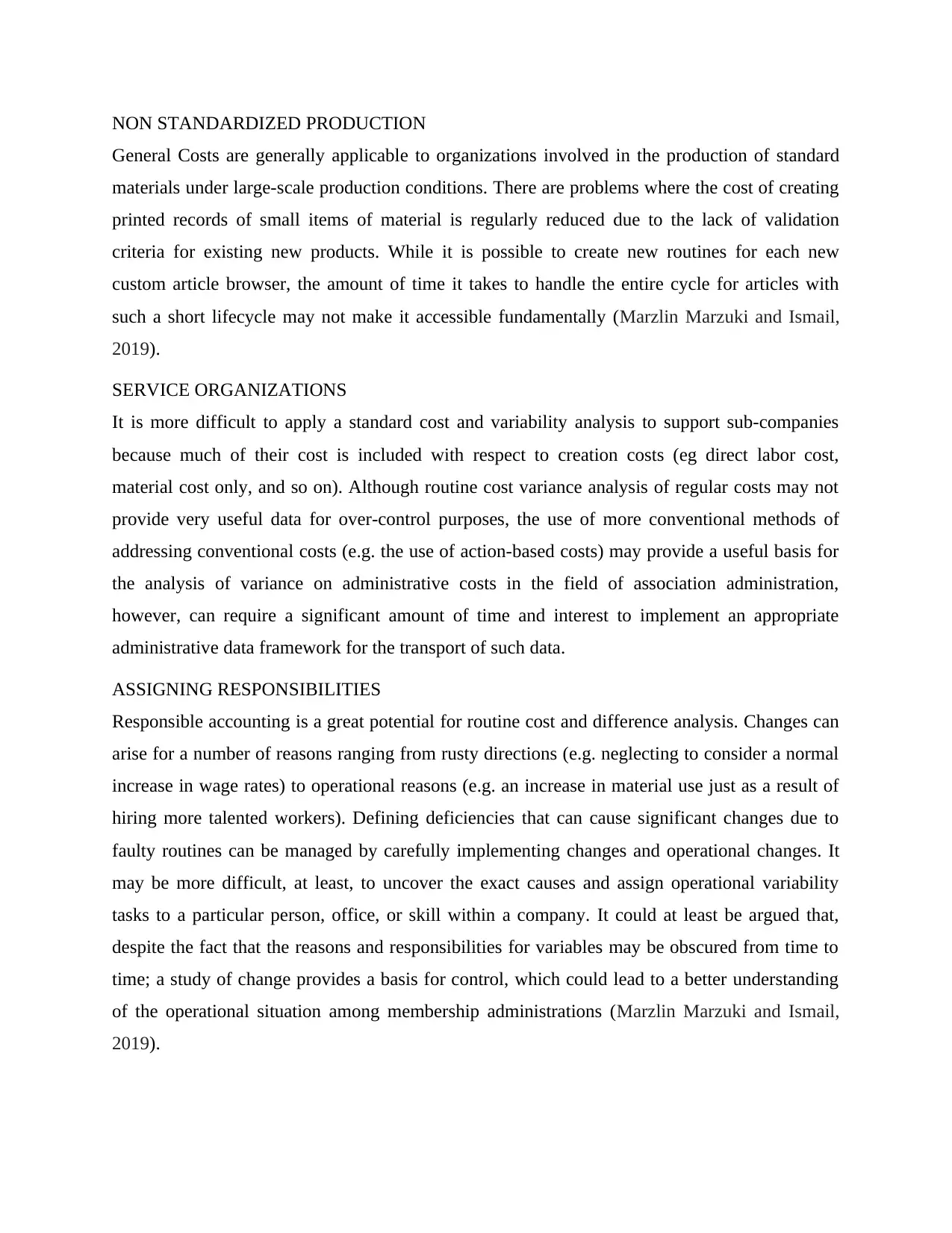
NON STANDARDIZED PRODUCTION
General Costs are generally applicable to organizations involved in the production of standard
materials under large-scale production conditions. There are problems where the cost of creating
printed records of small items of material is regularly reduced due to the lack of validation
criteria for existing new products. While it is possible to create new routines for each new
custom article browser, the amount of time it takes to handle the entire cycle for articles with
such a short lifecycle may not make it accessible fundamentally (Marzlin Marzuki and Ismail,
2019).
SERVICE ORGANIZATIONS
It is more difficult to apply a standard cost and variability analysis to support sub-companies
because much of their cost is included with respect to creation costs (eg direct labor cost,
material cost only, and so on). Although routine cost variance analysis of regular costs may not
provide very useful data for over-control purposes, the use of more conventional methods of
addressing conventional costs (e.g. the use of action-based costs) may provide a useful basis for
the analysis of variance on administrative costs in the field of association administration,
however, can require a significant amount of time and interest to implement an appropriate
administrative data framework for the transport of such data.
ASSIGNING RESPONSIBILITIES
Responsible accounting is a great potential for routine cost and difference analysis. Changes can
arise for a number of reasons ranging from rusty directions (e.g. neglecting to consider a normal
increase in wage rates) to operational reasons (e.g. an increase in material use just as a result of
hiring more talented workers). Defining deficiencies that can cause significant changes due to
faulty routines can be managed by carefully implementing changes and operational changes. It
may be more difficult, at least, to uncover the exact causes and assign operational variability
tasks to a particular person, office, or skill within a company. It could at least be argued that,
despite the fact that the reasons and responsibilities for variables may be obscured from time to
time; a study of change provides a basis for control, which could lead to a better understanding
of the operational situation among membership administrations (Marzlin Marzuki and Ismail,
2019).
General Costs are generally applicable to organizations involved in the production of standard
materials under large-scale production conditions. There are problems where the cost of creating
printed records of small items of material is regularly reduced due to the lack of validation
criteria for existing new products. While it is possible to create new routines for each new
custom article browser, the amount of time it takes to handle the entire cycle for articles with
such a short lifecycle may not make it accessible fundamentally (Marzlin Marzuki and Ismail,
2019).
SERVICE ORGANIZATIONS
It is more difficult to apply a standard cost and variability analysis to support sub-companies
because much of their cost is included with respect to creation costs (eg direct labor cost,
material cost only, and so on). Although routine cost variance analysis of regular costs may not
provide very useful data for over-control purposes, the use of more conventional methods of
addressing conventional costs (e.g. the use of action-based costs) may provide a useful basis for
the analysis of variance on administrative costs in the field of association administration,
however, can require a significant amount of time and interest to implement an appropriate
administrative data framework for the transport of such data.
ASSIGNING RESPONSIBILITIES
Responsible accounting is a great potential for routine cost and difference analysis. Changes can
arise for a number of reasons ranging from rusty directions (e.g. neglecting to consider a normal
increase in wage rates) to operational reasons (e.g. an increase in material use just as a result of
hiring more talented workers). Defining deficiencies that can cause significant changes due to
faulty routines can be managed by carefully implementing changes and operational changes. It
may be more difficult, at least, to uncover the exact causes and assign operational variability
tasks to a particular person, office, or skill within a company. It could at least be argued that,
despite the fact that the reasons and responsibilities for variables may be obscured from time to
time; a study of change provides a basis for control, which could lead to a better understanding
of the operational situation among membership administrations (Marzlin Marzuki and Ismail,
2019).
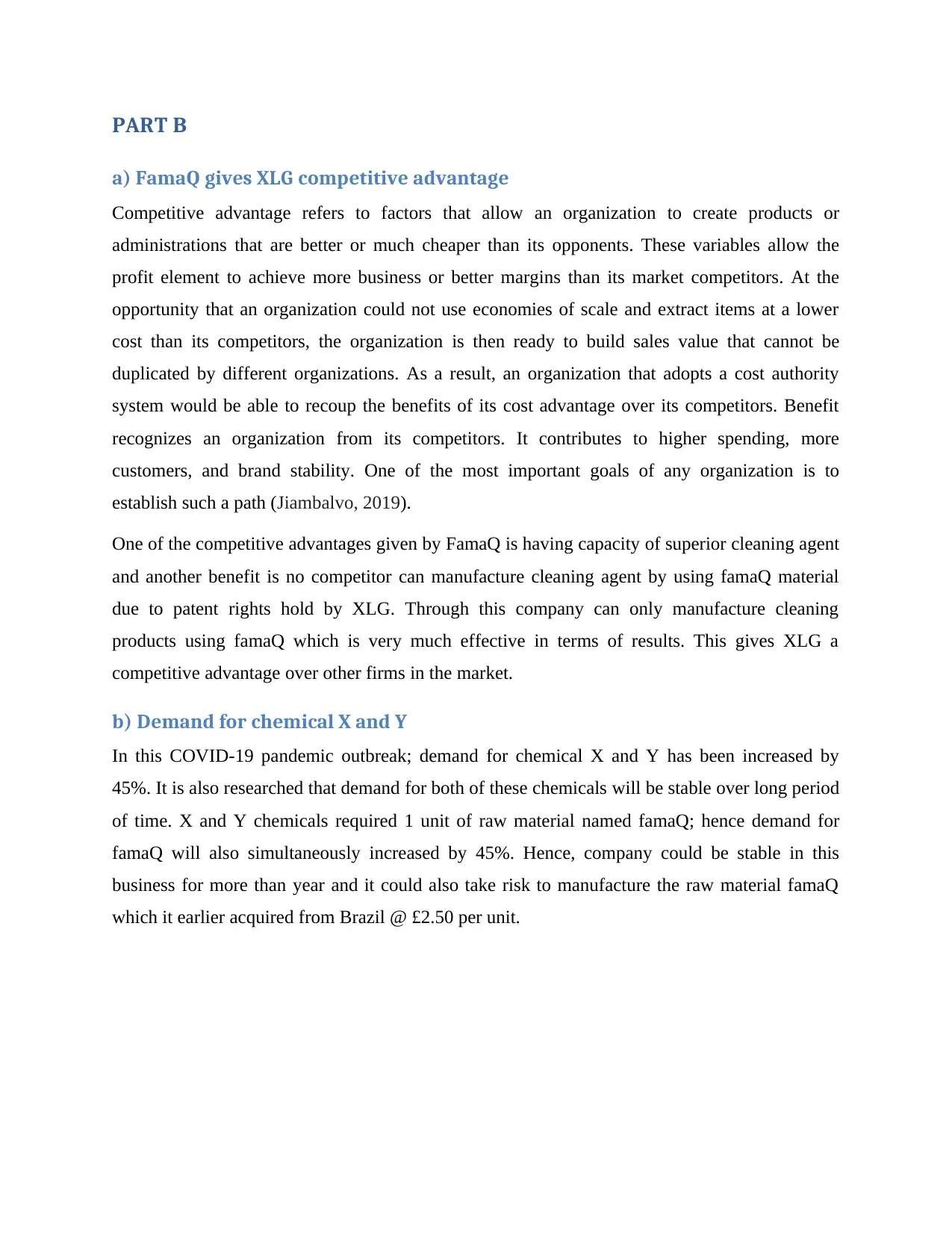
PART B
a) FamaQ gives XLG competitive advantage
Competitive advantage refers to factors that allow an organization to create products or
administrations that are better or much cheaper than its opponents. These variables allow the
profit element to achieve more business or better margins than its market competitors. At the
opportunity that an organization could not use economies of scale and extract items at a lower
cost than its competitors, the organization is then ready to build sales value that cannot be
duplicated by different organizations. As a result, an organization that adopts a cost authority
system would be able to recoup the benefits of its cost advantage over its competitors. Benefit
recognizes an organization from its competitors. It contributes to higher spending, more
customers, and brand stability. One of the most important goals of any organization is to
establish such a path (Jiambalvo, 2019).
One of the competitive advantages given by FamaQ is having capacity of superior cleaning agent
and another benefit is no competitor can manufacture cleaning agent by using famaQ material
due to patent rights hold by XLG. Through this company can only manufacture cleaning
products using famaQ which is very much effective in terms of results. This gives XLG a
competitive advantage over other firms in the market.
b) Demand for chemical X and Y
In this COVID-19 pandemic outbreak; demand for chemical X and Y has been increased by
45%. It is also researched that demand for both of these chemicals will be stable over long period
of time. X and Y chemicals required 1 unit of raw material named famaQ; hence demand for
famaQ will also simultaneously increased by 45%. Hence, company could be stable in this
business for more than year and it could also take risk to manufacture the raw material famaQ
which it earlier acquired from Brazil @ £2.50 per unit.
a) FamaQ gives XLG competitive advantage
Competitive advantage refers to factors that allow an organization to create products or
administrations that are better or much cheaper than its opponents. These variables allow the
profit element to achieve more business or better margins than its market competitors. At the
opportunity that an organization could not use economies of scale and extract items at a lower
cost than its competitors, the organization is then ready to build sales value that cannot be
duplicated by different organizations. As a result, an organization that adopts a cost authority
system would be able to recoup the benefits of its cost advantage over its competitors. Benefit
recognizes an organization from its competitors. It contributes to higher spending, more
customers, and brand stability. One of the most important goals of any organization is to
establish such a path (Jiambalvo, 2019).
One of the competitive advantages given by FamaQ is having capacity of superior cleaning agent
and another benefit is no competitor can manufacture cleaning agent by using famaQ material
due to patent rights hold by XLG. Through this company can only manufacture cleaning
products using famaQ which is very much effective in terms of results. This gives XLG a
competitive advantage over other firms in the market.
b) Demand for chemical X and Y
In this COVID-19 pandemic outbreak; demand for chemical X and Y has been increased by
45%. It is also researched that demand for both of these chemicals will be stable over long period
of time. X and Y chemicals required 1 unit of raw material named famaQ; hence demand for
famaQ will also simultaneously increased by 45%. Hence, company could be stable in this
business for more than year and it could also take risk to manufacture the raw material famaQ
which it earlier acquired from Brazil @ £2.50 per unit.
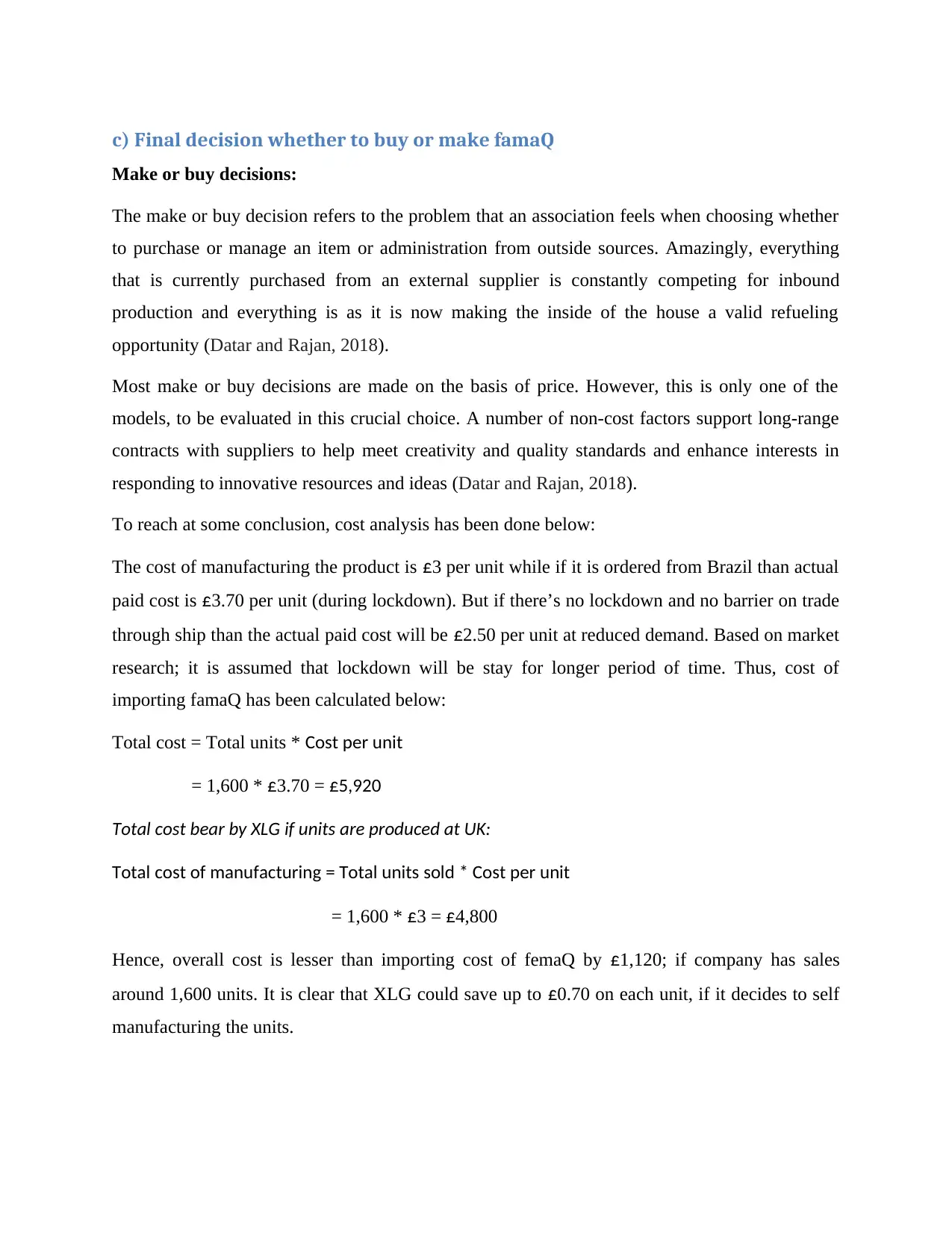
c) Final decision whether to buy or make famaQ
Make or buy decisions:
The make or buy decision refers to the problem that an association feels when choosing whether
to purchase or manage an item or administration from outside sources. Amazingly, everything
that is currently purchased from an external supplier is constantly competing for inbound
production and everything is as it is now making the inside of the house a valid refueling
opportunity (Datar and Rajan, 2018).
Most make or buy decisions are made on the basis of price. However, this is only one of the
models, to be evaluated in this crucial choice. A number of non-cost factors support long-range
contracts with suppliers to help meet creativity and quality standards and enhance interests in
responding to innovative resources and ideas (Datar and Rajan, 2018).
To reach at some conclusion, cost analysis has been done below:
The cost of manufacturing the product is £3 per unit while if it is ordered from Brazil than actual
paid cost is £3.70 per unit (during lockdown). But if there’s no lockdown and no barrier on trade
through ship than the actual paid cost will be £2.50 per unit at reduced demand. Based on market
research; it is assumed that lockdown will be stay for longer period of time. Thus, cost of
importing famaQ has been calculated below:
Total cost = Total units * Cost per unit
= 1,600 * £3.70 = £5,920
Total cost bear by XLG if units are produced at UK:
Total cost of manufacturing = Total units sold * Cost per unit
= 1,600 * £3 = £4,800
Hence, overall cost is lesser than importing cost of femaQ by £1,120; if company has sales
around 1,600 units. It is clear that XLG could save up to £0.70 on each unit, if it decides to self
manufacturing the units.
Make or buy decisions:
The make or buy decision refers to the problem that an association feels when choosing whether
to purchase or manage an item or administration from outside sources. Amazingly, everything
that is currently purchased from an external supplier is constantly competing for inbound
production and everything is as it is now making the inside of the house a valid refueling
opportunity (Datar and Rajan, 2018).
Most make or buy decisions are made on the basis of price. However, this is only one of the
models, to be evaluated in this crucial choice. A number of non-cost factors support long-range
contracts with suppliers to help meet creativity and quality standards and enhance interests in
responding to innovative resources and ideas (Datar and Rajan, 2018).
To reach at some conclusion, cost analysis has been done below:
The cost of manufacturing the product is £3 per unit while if it is ordered from Brazil than actual
paid cost is £3.70 per unit (during lockdown). But if there’s no lockdown and no barrier on trade
through ship than the actual paid cost will be £2.50 per unit at reduced demand. Based on market
research; it is assumed that lockdown will be stay for longer period of time. Thus, cost of
importing famaQ has been calculated below:
Total cost = Total units * Cost per unit
= 1,600 * £3.70 = £5,920
Total cost bear by XLG if units are produced at UK:
Total cost of manufacturing = Total units sold * Cost per unit
= 1,600 * £3 = £4,800
Hence, overall cost is lesser than importing cost of femaQ by £1,120; if company has sales
around 1,600 units. It is clear that XLG could save up to £0.70 on each unit, if it decides to self
manufacturing the units.
Secure Best Marks with AI Grader
Need help grading? Try our AI Grader for instant feedback on your assignments.
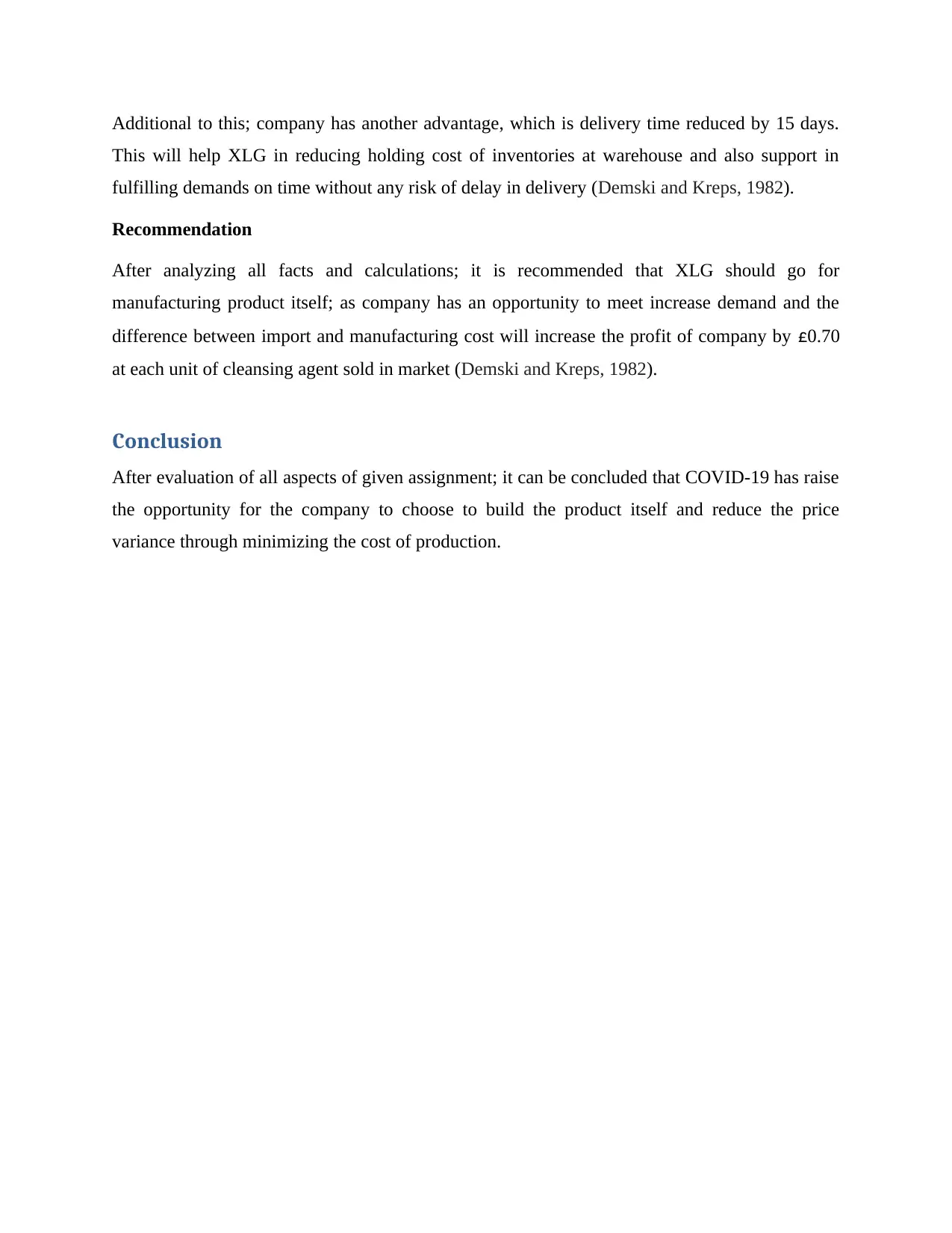
Additional to this; company has another advantage, which is delivery time reduced by 15 days.
This will help XLG in reducing holding cost of inventories at warehouse and also support in
fulfilling demands on time without any risk of delay in delivery (Demski and Kreps, 1982).
Recommendation
After analyzing all facts and calculations; it is recommended that XLG should go for
manufacturing product itself; as company has an opportunity to meet increase demand and the
difference between import and manufacturing cost will increase the profit of company by £0.70
at each unit of cleansing agent sold in market (Demski and Kreps, 1982).
Conclusion
After evaluation of all aspects of given assignment; it can be concluded that COVID-19 has raise
the opportunity for the company to choose to build the product itself and reduce the price
variance through minimizing the cost of production.
This will help XLG in reducing holding cost of inventories at warehouse and also support in
fulfilling demands on time without any risk of delay in delivery (Demski and Kreps, 1982).
Recommendation
After analyzing all facts and calculations; it is recommended that XLG should go for
manufacturing product itself; as company has an opportunity to meet increase demand and the
difference between import and manufacturing cost will increase the profit of company by £0.70
at each unit of cleansing agent sold in market (Demski and Kreps, 1982).
Conclusion
After evaluation of all aspects of given assignment; it can be concluded that COVID-19 has raise
the opportunity for the company to choose to build the product itself and reduce the price
variance through minimizing the cost of production.
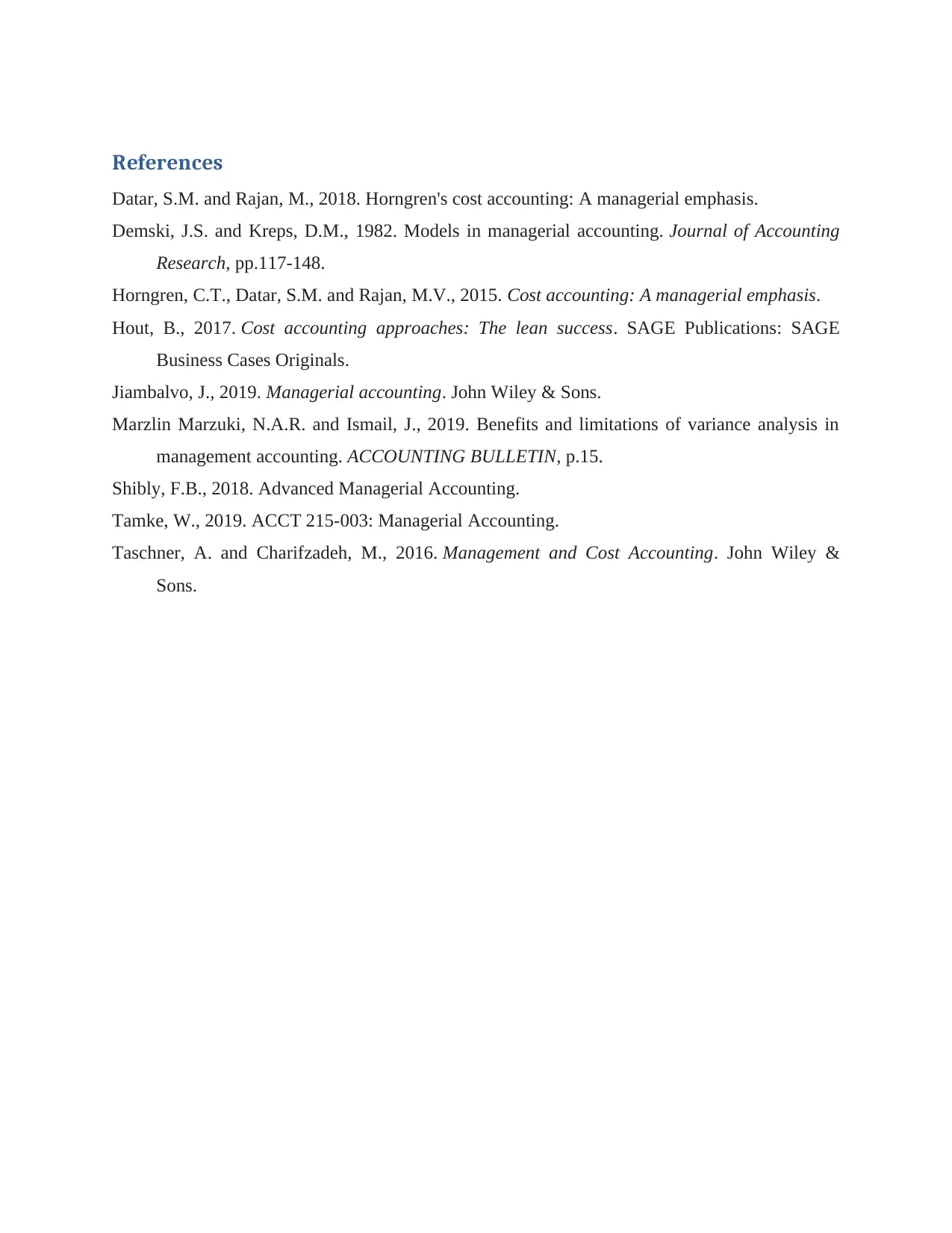
References
Datar, S.M. and Rajan, M., 2018. Horngren's cost accounting: A managerial emphasis.
Demski, J.S. and Kreps, D.M., 1982. Models in managerial accounting. Journal of Accounting
Research, pp.117-148.
Horngren, C.T., Datar, S.M. and Rajan, M.V., 2015. Cost accounting: A managerial emphasis.
Hout, B., 2017. Cost accounting approaches: The lean success. SAGE Publications: SAGE
Business Cases Originals.
Jiambalvo, J., 2019. Managerial accounting. John Wiley & Sons.
Marzlin Marzuki, N.A.R. and Ismail, J., 2019. Benefits and limitations of variance analysis in
management accounting. ACCOUNTING BULLETIN, p.15.
Shibly, F.B., 2018. Advanced Managerial Accounting.
Tamke, W., 2019. ACCT 215-003: Managerial Accounting.
Taschner, A. and Charifzadeh, M., 2016. Management and Cost Accounting. John Wiley &
Sons.
Datar, S.M. and Rajan, M., 2018. Horngren's cost accounting: A managerial emphasis.
Demski, J.S. and Kreps, D.M., 1982. Models in managerial accounting. Journal of Accounting
Research, pp.117-148.
Horngren, C.T., Datar, S.M. and Rajan, M.V., 2015. Cost accounting: A managerial emphasis.
Hout, B., 2017. Cost accounting approaches: The lean success. SAGE Publications: SAGE
Business Cases Originals.
Jiambalvo, J., 2019. Managerial accounting. John Wiley & Sons.
Marzlin Marzuki, N.A.R. and Ismail, J., 2019. Benefits and limitations of variance analysis in
management accounting. ACCOUNTING BULLETIN, p.15.
Shibly, F.B., 2018. Advanced Managerial Accounting.
Tamke, W., 2019. ACCT 215-003: Managerial Accounting.
Taschner, A. and Charifzadeh, M., 2016. Management and Cost Accounting. John Wiley &
Sons.
1 out of 12
Your All-in-One AI-Powered Toolkit for Academic Success.
+13062052269
info@desklib.com
Available 24*7 on WhatsApp / Email
![[object Object]](/_next/static/media/star-bottom.7253800d.svg)
Unlock your academic potential
© 2024 | Zucol Services PVT LTD | All rights reserved.





